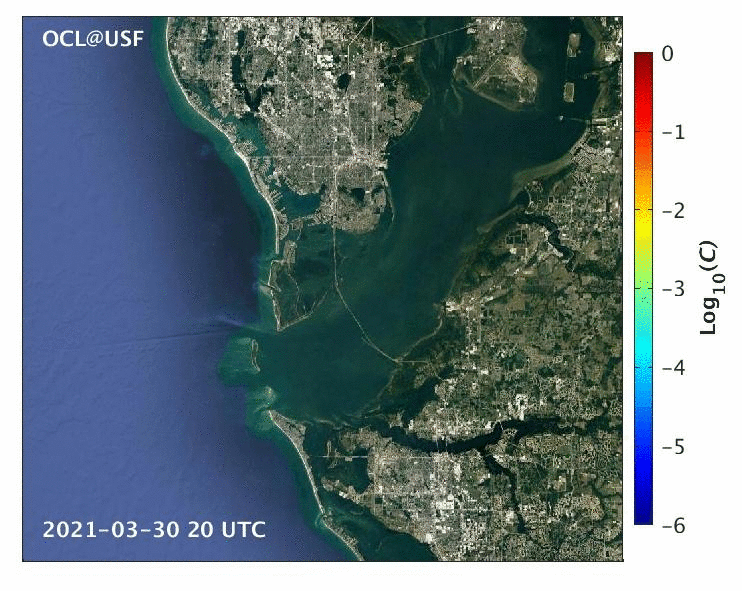
SECOORA members and funded scientists are responding to emergency wastewater discharge in Tampa Bay from a phosphate mining facility reservoir. According to the Florida Department of Environmental Protection, about 215 million gallons of polluted water from Piney Point, high in nutrients such as nitrogen, have been discharged in Tampa Bay, Florida to date (source).
Dr. Bob Weisberg and his team from University of South Florida College of Marine Science (USF CMS) Ocean Circulation Lab are modeling the fate of the nutrient rich water through partial support from SECOORA and US IOOS.
They implemented a tracer concentration code to track the pollutant plume as a rapid response. The team is now forecasting where the pollution bloom will move in the bay.
Modeling Where the Nutrient Pollutant Plume Will Move
As quoted in an article by MSN, Dr. Weisberg says his team is working to develop long-term forecasts to determine just how long it could take for the nutrient-rich water to spread out and dissipate.
“Will it end tomorrow, will it end a week from now, a month from now,” he said. “This is the only tool that enables one to start thinking into the future of what’s going to happen.” Read more.
The very high-resolution Tampa Bay Circulation Model publishes 1 day hindcast (probable past conditions) and a 3.5 day forecast (future conditions) each morning here.
The Tampa Bay Circulation Model is a numerical model that provides connectivity between three distinct ocean and coastal regions: deep ocean, nearshore shelf waters, and estuaries. Modeling nutrient rich water plume evolution is important to show where it may be transported.
Using the Model to Inform Officials Where to Monitor
During the first several days of the spill, Dr. Weisberg and Dr. Yonggang Liu (USF CMS), held frequent briefings to Tampa Bay Estuary Program and Florida Department of Environmental Protection to provide the forecasted plume patterns of the nutrient rich water. This helped officials plan where they should respond and take water samples. The team also participates in the Piney Point Monitoring Coordination Virtual Meeting every Monday morning to provide input and guidance in terms of the model forecast.
Impacts of the Pollutant Plume
While nutrient rich water has the potential to cause a Red Tide (Karenia brevis) bloom, it is too early to tell if this discharge will cause a Red Tide bloom in the Tampa Bay region.
According to Dr. Weisberg, there is clear visual evidence of phytoplankton growth where the nutrient concentrations are highest. Currently, low concentration Karenia brevis is observed in Sarasota Bay, which is connected to Tampa Bay in the southeast part. It could be complicated if the Piney Point wastewater meets the red tide species.
A Red Tide bloom can cause massive fish kills, weaken or kill marine mammals, and, when the toxin becomes aerosolized and inhaled, cause respiratory distress in humans and marine mammals. The Tampa Bay Circulation model is also used to track red tide.
Responding Quickly
USF CMS participated on a fast response research cruise on Florida Institutes of Oceanography’s R/V Weatherbird the first week of April. The response team collected samples and deployed pH and dissolved oxygen sensors to monitor the Piney Point wastewater situation. The data will be available to support the state’s effort to address the environmental impacts of the Piney Point reservoir release.
Pictured above are the three bottom mounted instrument packages deployed in Tampa Bay by USF Ocean Circulation Lab. These instruments are recording important water property data (chlorophyll a, dissolved oxygen, pH, temperature, and salinity) to assist in ground truthing the Tampa Bay Circulation Model results.
Observations Making it Possible to Model the Plume
USF CMS Ocean Circulation Lab’s Coastal Ocean Monitoring and Prediction System (COMPS) program serves real-time data to numerous end users. Data is critical to informing and developing predictive models that are applied to an array of coastal ocean issues. Piney Point is one example of the value provided by these predictive numerical modeling capabilities, which are a direct result of combining real time data observations with model data. USF CMS COMPS is partially funded by SECOORA and US IOOS.
Related news

New High Frequency Radar at the Dry Tortugas National Park Improves Ocean Surface Current Measurements Across the Straits of Florida
A new CODAR Low-Power SeaSonde HFR has been deployed by the University of South Florida at Fort Jefferson on Garden Key to measure surface currents to improve understanding and prediction of the Gulf of Mexico Loop Current.

President Biden Proposes Significant Budget Cuts to IOOS for 2025
President Biden’s recent 2025 budget proposal slashed the funding allocated for the Integrated Ocean Observing System (IOOS) by 76%, which would effectively shut down coastal and ocean observing efforts.

Webinar: NOAA Resources to Help Coastal Communities Understand Flood Risk
Join us Wednesday, March 27th at 12 PM Eastern Time for SECOORA's Coastal Observing in Your Community Webinar Series to hear from Doug Marcy with the NOAA Office for Coastal Management.